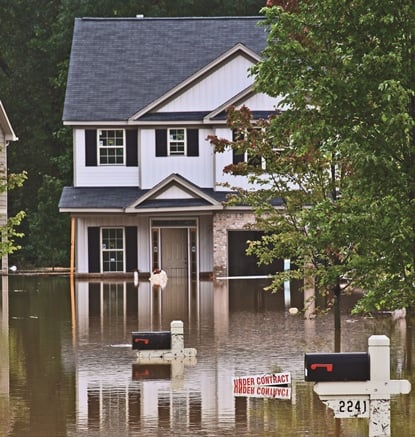After seeing such broad support in the House, it seemed only amatter of time before the Flood Insurance Market Parity andModernization Act would pass the Senate and become law. ForNational Association of Professional Surplus Lines Offices (NAPSLO)officials, though, the work continues to push what they see astheir top federal legislative priority across the finish line.
|The bill essentially clarifies language in the Biggert-WatersFlood Insurance Reform Act of 2012 (BW-12) regarding theability of privately issued flood insurance to meet lenders’mandatory purchase requirements. When BW-12 was originally reportedout of the House, it specified that lenders shall accept privateflood insurance for mandatory purchases. However, language addedlater in the process before BW-12 was passed led to confusion amonglenders evaluating policies for the purpose of mandatory floodinsurance requirements.
|The Flood Insurance Market Parity and Modernization Act definesprivate flood insurance as “a policy issued by a company licensed,admitted, or otherwise approved by the state.”
|“All we’re doing in this legislation is clarifying that thesurplus lines market is in fact an eligible market from which toaccept a private flood insurance policy,” says NAPSLO ExecutiveDirector Brady Kelley.
|“I say that because surplus lines insurers have long writtenflood insurance policies — this isn’t a new opportunity,” hecontinues. “Before BW-12 was signed, our market has always servedas a supplement to the NFIP. There are a number of homes andcommercial properties that don’t fit within the terms andconditions of the NFIP policy. So we’ve oftentimes served as anexcess option, or an option when the NFIP policy doesn’t do thetrick.”
|Kelley adds, “From that perspective, the primary goal is topreserve the types of solutions the market was alreadyproviding.”
|Related: How to avoid becoming a victim of 'flood vehicle'fraud
|
(Photo: Kelly Farrar)
|Senate version differs
Back in April, the House version of Flood Insurance Market Parityand Modernization Act, H.R.2901, easily passed by a vote of 419-0. Keri Kish, NAPSLO’sdirector of government relations, notes, however, that behind theapparent smooth sailing was actually the result of a lot of hardwork — work that began back in 2014 to educate legislators not juston the bill, but the surplus lines marketplace in general.
“It’s not something everyone just knows about and understands,”Kish says of surplus lines. “Our education really helped themunderstand how the surplus lines market functions as part of theprivate insurance market — how we developed and why it’s importantto maintain our ability to provide those options.”
|With respect to the Senate’s version of the bill, S.1639,discussions with legislators have a different twist than in theHouse. Kish says it is more a matter of timing than concern aboutsurplus lines. For one, Washington is in election mode, and someSenators are in tough races. On a related note, there is limitedtime left for the 114th Congress. Senators are wrapping up a numberof initiatives, and, depending on who controls the Novemberelection, there could be a lame duck session to close out theyear.
|“We’ll know more after the elections,” says Kish.
|Additionally, senators know that there will be increased focuson the topic of flood insurance next year as Congress will work ona reauthorization of the National Flood Insurance Program (NFIP).Some Senators, says Kish, wonder why they should address the floodissues in the Flood Insurance Market Parity and Modernization Actwhen they are going to spend so much time on flood next year.“Can’t we wait until then to address it?” Kish says,summing up the feelings of a handful of senators.
|“What we are emphasizing is this is a distinct issue fromreauthorization,” she says. “This is going to help the privatemarket develop, which was the key point of BW-12. We just need thisbill to pass in order to help effectuate that plan.”
|Related: The aftermath: Louisiana insurance agents assist clients whiledealing with own losses
|
(Photo: iStock)
|Bill has bi-partisan support
Kelley concurs: “We see this as an important first step inpromoting the private market as an alternative to the NFIP.”
He adds, “Again, our interest in the beginning was preservingwhat the surplus lines market was able to underwrite.” But he addsthat, as legislators talk about reforming the NFIP, with broadagreement that the private market should be prepared to offer moresolutions, passing S.1639 is a logical first step.
|“Let’s put that in place now,” says Kelley. “Let’s let theindustry respond to that and start to develop new products —commercial and residential property products — as Congress furtherworks to reform the NFIP in 2017.”
|NAPSLO members are optimistic about getting S.1639 passed,although, as Kish states, “We are optimistic but we’re alsorealistic.” She says work will continue as far as holding furtherdiscussions with key senators — particularly those on the SenateBanking Committee. “For members that indicate support, we’ll askthem to sponsor the legislation and to talk to their fellow membersin regards to sponsoring,” she says.
|Scott Culler, NAPSLO Legislative Committee Co-Chair and regionalpresident, Markel West Insurance Services, says the overallstrategy from the House to the Senate is the same: “I think it’sthe same process of making sure we educate the senators on whatwe’re trying to get accomplished — and that we’re not trying toreplace NFIP, but to supplement it.”
|Lana Parks, NAPSLO Legislative Committee Co-Chair and presidentof managing general agency The Parks Group, Inc., says “It hassupport in the House Financial Services Committee, where it passed53-0, and then passage by the full House 419-0 — I think thatspeaks volumes about the amount of support this measure has. Thisis non-controversial.
|She adds, “I’m optimistic it will pass this year. There’s noreason not to do it now. Ultimately this is giving consumerschoices. I can see no policy concerns in passing it this year.”
|As for the potential impact on the marketplace, Parks sayscarriers she represents do not currently offer many flood products,but with the clarity provided by this bill, “I do see it as anopportunity — as something we should consider pursuing. If you’redoing a package [property] policy, it only makes sense to offerother perils that you can cross-sell and offer whole coverage.”
|Related: Time to act on flood bill
|Save
|Save
|Save
|Save
|Save
Want to continue reading?
Become a Free PropertyCasualty360 Digital Reader
Your access to unlimited PropertyCasualty360 content isn’t changing.
Once you are an ALM digital member, you’ll receive:
- All PropertyCasualty360.com news coverage, best practices, and in-depth analysis.
- Educational webcasts, resources from industry leaders, and informative newsletters.
- Other award-winning websites including BenefitsPRO.com and ThinkAdvisor.com.
Already have an account? Sign In
© 2024 ALM Global, LLC, All Rights Reserved. Request academic re-use from www.copyright.com. All other uses, submit a request to [email protected]. For more information visit Asset & Logo Licensing.








